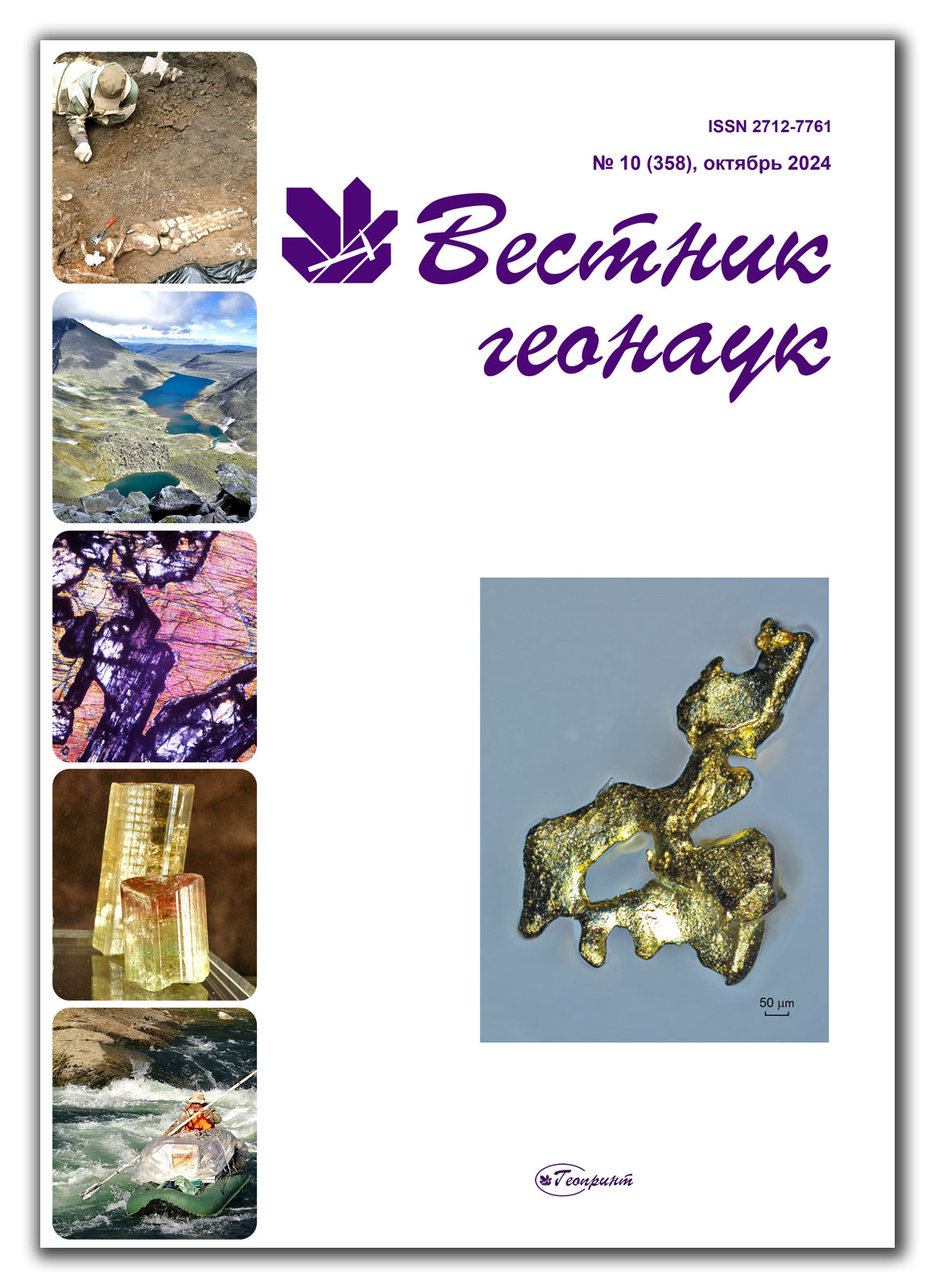|
On the cover: authigenic gold from the Novobobrovskoye Nb-TR deposit.
Photo by B. A. Makeev, Nikon Eclipse LV100ND optical microscope
|
|
| |
|
|
 Title page Title page
|
1
|
|
 Content Content
|
2
|
| |
|
|
|
|
Научные статьи / Scientific articles
|
Dolomite-sepiolite interaction in Kashira and Podolsk deposits of platform part of Bashkortostan: possible biogenic origin
R. V. Mirnov, A. A. Nikolaev
|
3—11
|
Mineral springs of the Yaneytyvis deposit of mineral waters (Komi Republic)
Т. P. Mityusheva
DOI: 10.19110/geov.2024.10.2
In the area of the Yaneytyvis deposit of mineral waters on the Chernov Ridge, three groups of springs with mineralization of 2.3—3.0 g/l and surface waters were tested. The mineral water deposit, the largest in terms of proven reserves in the Arctic zone of Russia, is not exploited. The mineral waters of the springs of the subcryogenic Lower Carboniferous aquifer complex are weakly alkaline, low-mineralized, calcium-sodium chloride. A change in the anionic composition of the waters (a decrease in the proportion of sulfate ion) was established with a constant Cl Ca hydrochemical type. The first data were obtained on the isotopic composition of the mineral waters of the Yaneytyvis springs (dD –111.9...–109.2 ‰ (SMOW), d18О –15.78...–15.15 ‰ (SMOW), values are close to the thermomineral waters of the springs on the Pymvashor River on the Chernyshev Ridge. Various types of water participate in the formation of the composition of the mineral waters of the springs: fresh waters of modern atmospheric precipitation formed in cold climates and melt waters from degrading permafrost, as well as salty chloride-sodium waters of marine (mixed) genesis of the aquifer complex of carbonate deposits of the Lower Carboniferous. Surface waters of the Bolshezemelskaya tundra in the area of the springs have a diverse composition (HCO3 Ca–Mg, HCO3–Cl Ca–Na, Cl Na–Ca, Cl–HCO3 Mg), their pollution with microelements of natural and technogenic origin has been established.
Keywords: Yaneytyvis spring, underground water, mineral water, hydrochemistry, isotopic composition, Chernov ridge
 Download full text Download full text
|
12—27
|
Technological mineralogy of strategic metal ores: achievements, problems, prospects
E. G. Ozhogina, O. B. Kotova
|
28—34
|
From teaching experience. XV. Crystallographic borders and phyllotaxis
Yu. L. Voytekhovsky, A. D. Gunchenkova
DOI: 10.19110/geov.2024.10.4
Phyllotaxis is an orderly arrangement of leaves on plant stems and branches. Its origin is that each species in the course of evolution optimized the light flux for each leaf. The found optimum was fixed in the genotype and became a phenotypic trait. The possibility to use the crystallographic ideas in botany was shown by A. Bravais. The given paper proposes to describe the arrangement of leaves on a horizontal branch in terms of the theory of borders. All seven possible types of borders are found to be theoretically consistent. The suggested nomenclature in terms of symmetry operations strictly fixes straight and oblique arrangement of symmetrical and asymmetrical leaves on branches. Botanical prototypes have been established for all types of borders.
Keywords: crystallography, systematics and hierarchy of borders, phyllotaxis
 Download full text Download full text
|
35—39
|
|
|
Effect of shungite plate thickness on its electrophysical properties: technological and geophysical aspects
Ye. A. Golubev, I. V. Antonets
DOI: 10.19110/geov.2024.10.5
This brief report presents the results of our study of the effect of shungite sample thickness (both shungite rocks and vein forms comparable to higher anthraxolites) on their electrophysical properties. The study was conducted by measuring impedance in the frequency range of 0.05–15 MHz. Shungite samples with a carbon content of 96, 95, 73, and 38 at. % and a thickness ranging from 5 mm to 12–15 µm were studied. A significant increase in resistance was found with a decrease in sample thickness to 100 µm or less. In this case, the inductive resistance typical of shungite macrosamples changes to capacitive resistance or only active resistance appears. Thus, it is shown that not only the total content, but also the form and dimensionality of the occurrence of such carbon affects the electrophysical properties of the rock. The obtained results can be used to interpret electrical exploration data of rocks containing disordered carbon (shungites, anthraxolites) in vein and lenticular form, and also to show new prospects for the use of such carbon in the development of functional materials.
Keywords: shungite, electrophysical properties, impedance, microstructure
 Download full text Download full text
|
40—45 |
| |
|
|
Chronicle, events, facts. History of Science
|
| |
|
|
The role of the RMS Technological Mineralogy Commission in improving the completeness and integrity of mineral raw utilization
 Download full text Download full text
|
46—52 |
|
|













